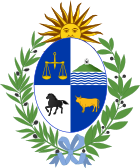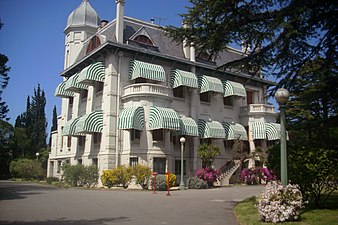President of Uruguay
This articleneeds additional citations forverification.(July 2019) |
| President of the Oriental Republic of Uruguay | |
|---|---|
| Presidente de la República Oriental del Uruguay | |
 | |
| Style | Mr. President (spoken) President of the Republic (official) |
| Status | Head of state Head of government |
| Residence | Residencia de Suárez |
| Seat | Executive Tower,Montevideo |
| Appointer | Popular Vote Election |
| Term length | Five years, renewable non-consecutively |
| Constituting instrument | Constitution of Uruguay |
| Inaugural holder | Fructuoso Rivera |
| Formation | 6 November 1830 |
| Deputy | Vice President of Uruguay |
| Salary | $U403,242/US$ 10,339 per month[1] |
| Website | presidencia.gub.uy |
 |
|---|
|
|
Thepresident of Uruguay(Spanish:presidente del Uruguay), officially known as thepresident of the Oriental Republic of Uruguay(presidente de la República Oriental del Uruguay), is thehead of stateandhead of governmentofUruguay.Their rights are determined in theConstitution of Uruguay.Along with the Secretariat of the Presidency, theCouncil of Ministersand the director of theOffice of Planning and Budget,the President is part of theexecutive branch.In case of absence, their office is exercised by thevice president.In turn, the president of the republic is the commander in chief of theArmed Forces.
Since 1990, the president's term has begun and ended on 1 March. This same date for ending the presidency also happened during theNational Council of Government(1952–1967) and it has been not unusual since 1839. The current president since 1 March 2020 isLuis Lacalle Pou,who is the 42nd president of Uruguay—and also the child of the 36th president,Luis Alberto Lacalle.
Features of the office[edit]
Requirements[edit]
TheConstitutionamendment establishes the requirements for becoming president. Article 151 establishes that the president must be anatural-born citizenof the country, or have been born to an Uruguayan citizen if born abroad. The president must also be at least 35 years old and be registered in the National Civic Registry.[2]
Election[edit]
According to the current ConstitutionConstitution of Uruguay of 1967orConstitution of Uruguay of 1997,[3]the president is elected by direct popular vote for a term of five years. A person may be reelected to the presidency any number of times, but is ineligible for immediate reelection.[4]The president and vice president run on a single ticket submitted by their party. In case no candidate obtains an absolute majority of votes (50%+1), arunoffis held between the top two candidates. In this case, the candidate who obtains a plurality in the runoff wins the election.
Powers and duties[edit]
According to Article 168 of the Constitution, the president, acting with the respective minister or ministers, or the Council of Ministers, includes, is assigned:
- The preservation of order and tranquility within and security without.
- The command of all armed forces.
- The promulgation of all laws, issuingspecial regulationsnecessary for its implementation.
- The delivery, to theGeneral Assembly of Uruguayat the opening of regular sessions, the state of the Republic address.
- The right to veto laws he dislikes.
- The right to propose bills or amendments to laws previously enacted.
- The dismissal of public employees for misfeasance, malfeasance or nonfeasance.
- Management ofdiplomatic relationsand, with consent of the legislature, the right to declare war.
- The right to declare astate of emergencywhen needed.
- The preparation of the state budget.
- Negotiation of treaties with the ratification of the legislature.
Succession[edit]
Article 153 of the Constitution establishes that in the event of absence, resignation, cessation, or death of the President and Vice President, the Presidency of the Republic shall be assumed by the first titular Senator of the list most voted for of the political party by which they were elected.[2]
Residence[edit]
TheSuárez ResidenceinMontevideois theofficial residenceof the president. The site was acquired by Adelina Lerena de Fein at auction, and the construction of a three-storey house by the young architectJuan María Aubriot,was ordered by Fein Lerena family. In 1925, the youngLuis Batlle BerresandMatilde Ibáñez Tálicemet while walking in front of this property. Soon after they were married. In 1947,Luis Batlle Berreswas already head of state, and at the suggestion of his spouse they chose this mansion as their official residence.[5]
TheAnchorena Presidential Estateis the president's country residence. Located in theColonia Department,208 kilometers fromMontevideo,is the result of the legacy of the aristocrat Aarón de Anchorena who gave about 1,369 hectares of his estate to the Uruguayan State. The mansion combines theNormanandTudorstyles.[6]
The president also has the use of a mansion inPunta del Este,which is called "Woodland’s," and serves as a vacation residence. It was donated to the Uruguayan State by the Argentine businessman Mauricio Litman.[7]
- Presidential residences
-
Residencia de Suárez,the official residence
-
Anchorena Presidential Estate,the official retreat
See also[edit]
References[edit]
- ^https://www.gub.uy/junta-transparencia-etica-publica/sites/junta-transparencia-etica-publica/files/2020-08/Dr.%20Lacalle%20Pou%202020.pdf[bare URL PDF]
- ^ab"Constitución de la República Oriental del Uruguay".www.impo.com.uy.Retrieved1 May2020.
- ^https://web.archive.org/web/20150329211901/http://www.parlamento.gub.uy/constituciones/const004.html[dead link]
- ^"Constitución de la República Oriental del Uruguay".www.impo.com.uy.Retrieved1 May2020.
- ^"Diario EL PAIS – Montevideo – Uruguay".historico.elpais.com.uy.Retrieved3 August2020.
- ^"Bush se reúne en Uruguay con el primer presidente de izquierdas del país | elmundo.es".www.elmundo.es.Retrieved2 August2020.
- ^"La historia de la residencia presidencial de Punta del Este, donada al Estado a fines de los 40' por un empresario argentino".Teledoce.com(in Spanish). 17 February 2021.Retrieved21 February2021.





